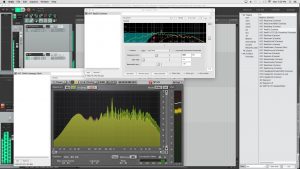This video taught me about phase change in EQ. It freaked me out a bit because I’ve used plenty of EQ in parallel processing during mixing on reverb and drum compression sends.
I did some testing in Reaper that reassured me that I haven’t made egregious mistakes in my mixes. The phase change around an EQ’s cutoff frequency is worth keeping in mind, but doesn’t drastically affect the summed output of signals in parallel.

What you see above is my test Reaper session. Fuzz’s song “Rat Race” is on two tracks playing in parallel; one has a high pass filter at 500 Hz (the top plugin window) and it’s phase change is also displayed as the orange line. You can see that the EQ’d signal is somewhat out of phase with the unprocessed signal well above 500 Hz, potentially resulting in phase cancellation above 500 Hz when the signals are summed.
The spectrum analyzer (lower plugin window) shows the summed signals (the green background spectrum) and the unprocessed signal by itself (the pink foreground spectrum, which mostly looks lighter green where it’s overlaid on the summed signal).
What I notice is that the difference between the original (green) and parallel-processed-and-EQ’d (pink) signals diverges right at about 500 Hz and the difference is pretty consistent above that point. For me, this is great news; the parallel processing behaves almost exactly as I naively expected it would, before I knew about the phase change described in the video.
A bad result would have been if the difference between the green and pink spectra began diverging around 500 Hz but grew slowly, up to 5K or 10K. That would have meant that in my mixes, I was losing information between (in this example) 500 Hz and 10K without realizing it or compensating for the loss.
tl;dr – Sighs of relief and feelings of bullets dodged in the Studio/Laundry Room of Fury.
